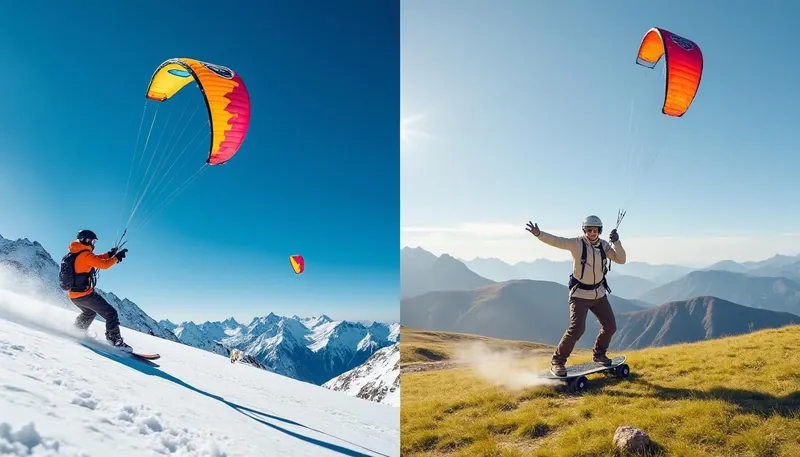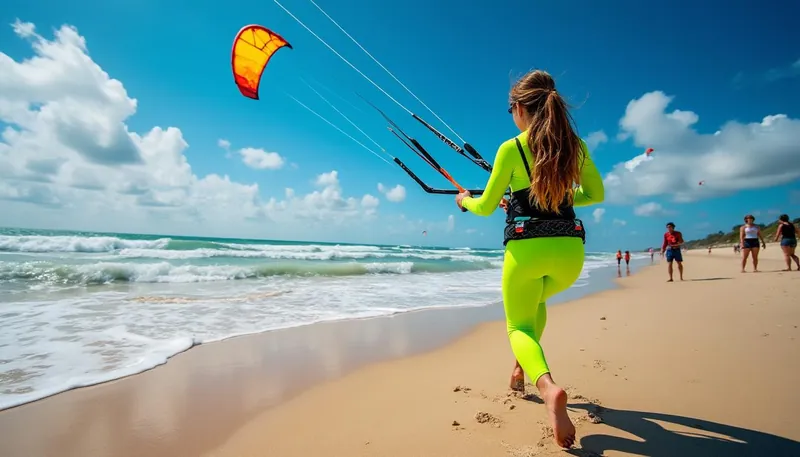Snowkiting and landboarding have gained considerable popularity in the outdoor sports community. With the exhilarating rush of harnessing the wind’s power while gliding across snow or land, more enthusiasts are curious about the feasibility of using a power kite for these activities. Power kites are not just toys; they are versatile tools that can effectively enhance a rider’s experience. But how exactly do these kites work in different terrains, and what’s needed for safety and enjoyment? Let’s dive into the core aspects to understand if you can indeed use a power kite for snowkiting or landboarding.
Brief
- 🌬️ Power kites can be effectively used for both snowkiting and landboarding.
- ❄️ Snowkiting requires specific types of kites best suited to snowy terrains.
- 🛹 Landboarding offers a different set of experiences, best paired with the right power kite.
- ⚠️ Safety gear and understanding the kite dynamics are crucial for both sports.
- 🧗♂️ Adapt your choice of surface and kite size to maximize performance.
Understanding Power Kites and Their Applications
Power kites are designed to harness wind energy effectively. By learning how to control these kites, riders can glide smoothly and swiftly across various surfaces, whether it be snow or land. To get started, let’s break down the basics of power kites and their versatility.
What Exactly is a Power Kite?
A power kite utilizes the force of the wind to propel the user forward. These kites can come in various designs, such as inflatable leading-edge kites or foil kites. Foil kites, which are more suitable for snowkiting, lack a rigid frame, making them lightweight and easier to handle. This characteristic allows them to adapt quickly to changing wind conditions, giving users more control.
Understanding the wind conditions is crucial when using power kites. Typically, their efficiency is gauged by aspects like size and design:
- 🌪️ Size Matters: Larger kites generate more power but require stronger winds. For light winds, smaller kites are recommended.
- ⚙️ Design Variance: Opt for foil designs when tackling snow versus inflatable ones which are more suited for landboarding.
- 👨🏫 Control Types: Two-line kites are great for beginners, while four-line kites provide more stability suitable for serious sports like snowkiting.
Applications in Snowkiting Versus Landboarding
While both sports utilize power kites, their applications differ. Here’s a quick overview of how power kites can be used in each setting:
| Aspect | Snowkiting | Landboarding |
|---|---|---|
| Surface | Snow or Ice | Dry Land or Pavement |
| Preferred Kite Type | Foil Kites | Inflatable or Foil Kites |
| Weight Considerations | More forgiving on snow | Requires more maneuverability |
| Learning Curve | Generally easier to learn | Varies depending on terrain |
Choosing the Right Gear for Snowkiting
If you are geared towards snowkiting, there are specific factors you need to take into account to have a fantastic experience. The target is to get the most fun while ensuring safety. Let’s break down the necessary equipment to help you hit the snowy terrains effectively.
Types of Kites Suitable for Snowkiting
In the north during winter, a variety of kites can be utilized for snowkiting; however, the right choice can make all the difference. Here are critical aspects to remember while selecting kites:
- 🪁 Foil Kites: Ideal for snow due to their durability and ease of launch. They can withstand crashes without an airframe to puncture.
- 🌈 De-Powering Kites: These kites let you manage power as you ride, making the experience smoother, especially in gusty conditions.
- 🚀 Kite Size: For common wind ranges of 14-20 mph, a 5.0 sq meter kite is excellent. Lighter winds (10-15 mph) call for larger kites.
Terrain Considerations
It’s not just about the kite; your snow surface also matters. Ideal spots for snowkiting should be unobstructed, flat, and with the right snow condition:
- 🏞️ Frozen Lakes: Typically the best choice due to fewer obstacles and steady winds.
- ❄️ Powder vs. Hardpack: Powder can be trickier; hence understanding the type of snow helps in selecting appropriate kite size.
Key Factors for Landboarding with Power Kites
Switching gears to landboarding, this discipline offers its own unique flavor and challenges. Choosing the right equipment and understanding the terrain is essential for safety and performance.
Choosing the Perfect Landboarding Gear
Whether you’re starting or looking to upgrade your gear, understanding the functionalities will set you apart. Here are critical factors to consider:
- 🛹 Board Type: Choose a landboard designed for different terrains, ensuring stability and maneuverability.
- 💪 Kite Type: Opt for inflatable kites that allow flexibility when navigating different surfaces.
- ⚙️ Suitable Size: Beginners should prefer a smaller kite to avoid overpowering and a more manageable experience.
Safety and Self Training
When getting started with landboarding, safety should be a priority. Here’s how to ensure a smooth ride:
- 🎒 Protective Gear: Always equip yourself with helmets, knee and elbow pads.
- 🌬️ Check Wind Conditions: Understand the weather before heading out. Strong winds can make landboarding challenging.
- 👥 Practice Makes Perfect: Invest time in practicing with a smaller kite before progressing to more powerful ones.
Essential Tips for Maximizing Your Kite Experience
Improving your power kite performance boils down to mastering techniques and understanding your equipment. Here’s a quick guide to boost your game whether you’re into snowkiting or landboarding.
Mastering Control Techniques
Good kite control is essential for both snowkiting and landboarding. Here are skills you should develop:
- 🪄 Pull Handling: Learn to adjust your body position based on kite pull.
- 🤸 Body Positioning: Lean forward while going fast; it enhances balance and control.
- 🛑 Stop Quickly: Learn how to depower your kite quickly if you’re overpowered.
Utilizing Community Resources
Engaging with the kite community can dramatically enhance your experience:
- 🙌 Join Local Groups: Being part of communities like SnowKiteGear can offer valuable tips and more safety experiences.
- 📚 Watch Tutorials: Leveraging platforms like YouTube to watch professionals can provide insight into correcting common mistakes.
Can any power kite be used for snowkiting?
Not all power kites are suitable; foil kites are preferred due to their durability and performance in snow.
What should I wear to ensure safety during landboarding?
Wear essential protective gear such as helmets and padding to reduce injury risk.
How do I know the right size kite for my weight?
A general guideline is to use a 3.5 m² kite for under 180 lbs, and a 5.0 m² kite for over 180 lbs.
What terrain is best for snowkiting?
Frozen lakes and flat areas without obstacles provide ideal conditions for snowkiting.
How can I learn to control my kite better?
Practice regularly, engage with experienced members in kite riding communities, and watch instructional videos.


